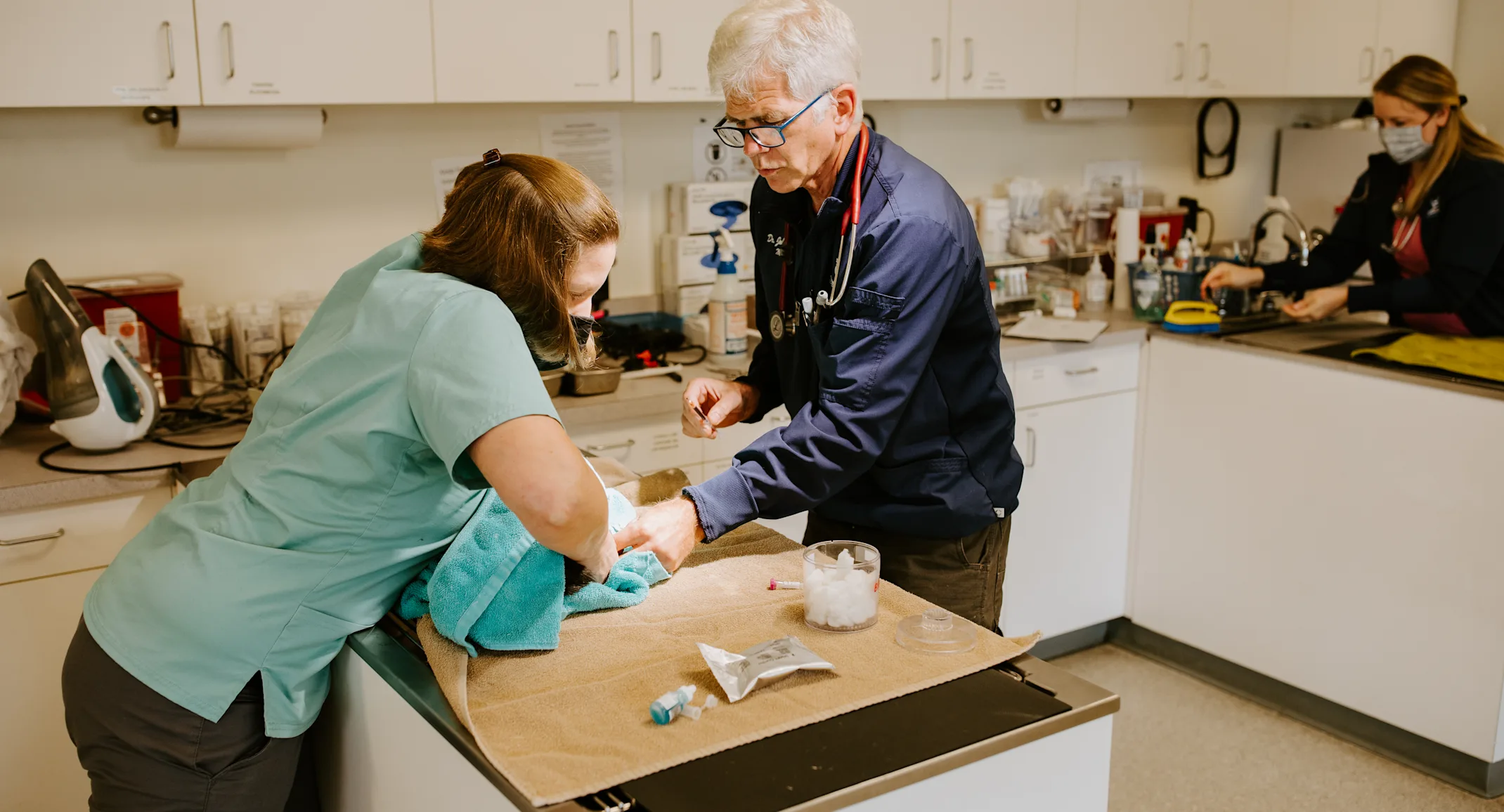The Importance of Pet Immunizations
The Exam Room

What vaccines does my dog need?
Vaccinations protect dogs from many infectious diseases, often preventing their deaths. Core vaccines for dogs include:
Rabies — Rabies is a viral disease most commonly transmitted through an infected animal’s bite. Wild animals—bats, foxes, raccoons, and skunks—can transmit this zoonotic infectious disease, to which humans are also susceptible. The virus attacks the neurologic system, and signs include fever, excess salivation, mental confusion, and paralysis. Once signs occur, the disease is almost always fatal. Many states’ laws require dogs to have the rabies vaccine, which is mandatory if you and your dog will be traveling outside the U.S.
Canine parvovirus — Parvovirus is a highly contagious virus that targets a dog’s gastrointestinal tract. Infection occurs through direct dog-to-dog contact, or when a dog comes in contact with contaminated feces, objects, or surfaces. Canine parvovirus signs include fever, abdominal pain, vomiting, and severe—often bloody—diarrhea. Without prompt treatment, parvo can quickly become fatal.
Canine distemper — Canine distemper is a viral disease that attacks a dog’s respiratory, gastrointestinal, and nervous systems. Most commonly, an infected dog transmits the disease through respiratory droplets. Canine distemper signs include fever, nasal discharge, lethargy, diarrhea, and vomiting. If the virus progresses to a dog’s nervous system, they may exhibit circling behavior, head tilt, muscle twitches, and seizures. Unfortunately, distemper is often fatal.
Infectious canine hepatitis (ICH) — An adenovirus shed in an infected dog’s urine, nasal discharge, and eye secretions cause ICH, which spreads when a dog comes in contact with these infective bodily fluids. ICH signs include fever, decreased appetite, nasal discharge, and cough. Some dogs develop corneal cloudiness one to two weeks after infection. In severe cases, dogs can experience significant liver damage.
Canine parainfluenza — Canine parainfluenza is a highly contagious virus that is part of the canine infectious respiratory disease (CIRD) complex (i.e., kennel cough). Canine parainfluenza signs include fever, cough, and nasal discharge.
Many available vaccines are optional. Depending on your dog’s lifestyle and where you live, your veterinarian will suggest your dog receive certain non-core vaccines, such as:
Bordetella bronchiseptica — B. bronchiseptica is a bacterial pathogen associated with kennel cough. Veterinarians often recommend this vaccine for dogs who commonly encounter other dogs, such as at a dog park or boarding facility.
Canine influenza — Canine influenza is a viral pathogen associated with kennel cough. Veterinarians often recommend this vaccine for dogs who commonly encounter other dogs, such as at a dog park or boarding facility.
Leptospirosis — Leptospirosis is a bacterial infection that dogs most commonly contract by ingesting urine-contaminated water. People are also susceptible, and can be infected by contaminated water, or their infected pet’s urine. Leptospirosis signs in dogs include fever, lethargy, diarrhea, and jaundice. Veterinarians often recommend this vaccine for dogs who frequently swim, or drink from natural water sources, such as ponds.
Lyme disease — Ticks transmit Lyme disease, which causes fever, swollen lymph nodes, and lethargy. Veterinarians often recommend this vaccine for dogs living in areas where ticks are prevalent.
What vaccines does my cat need?
Vaccinations also protect cats from many infectious diseases, often preventing their deaths. Core vaccines for cats include:
Feline panleukopenia — The virus that causes panleukopenia (i.e., feline distemper) attacks the rapidly growing cells in a cat’s bone marrow and intestines, and in a pregnant cat’s developing fetus. Cats can contract distemper by coming into contact with an infected cat’s urine, feces, or nasal secretions. Feline distemper signs include lethargy, vomiting, diarrhea, fever, and decreased appetite.
Feline calicivirus — The highly contagious feline calicivirus causes respiratory infections and oral disease. Cats can contract calicivirus when they come in contact with an infected cat’s saliva, nasal discharge, or ocular secretions. Feline calicivirus signs include sneezing, nasal discharge, conjunctivitis, and oral ulcers.
Feline herpesvirus type I — Feline herpesvirus type I causes an upper respiratory disease known as feline viral rhinotracheitis (FVR). Cats can contract FVR when they come in contact with an infected cat’s saliva, nasal discharge, and ocular secretions. FVR signs include sneezing, nasal discharge, and conjunctivitis.
Rabies — Rabies is a deadly virus that attacks the nervous system.
Many available vaccines are optional. Depending on your cat’s lifestyle and where you live, your veterinarian will suggest your cat receive certain non-core vaccines, such as:
Feline leukemia virus (FeLV) — FeLV suppresses a cat’s immune system, predisposing them to deadly infections. Cats can contract FeLV when they come in contact with an infected cat’s saliva, blood, urine, or feces. FeLV signs include decreased appetite, progressive weight loss, enlarged lymph nodes, persistent fever, poor coat condition, and recurring skin, urinary bladder, and upper respiratory tract infections. Veterinarians often recommend this vaccine for cats who have outdoor access, or who are frequently boarded.
Feline immunodeficiency virus (FIV) — FIV attacks a cat’s immune system, predisposing them to other infections. Cats who are bitten by an infected cat most commonly contract this virus. FIV signs include fever, lymph node enlargement, and lethargy. As the disease progresses, the infected cat may develop chronic and recurrent infections. Veterinarians often recommend this vaccine for cats living with an FIV-infected cat, and for cats who have outdoor access.
Bordetella bronchiseptica — B. bronchiseptica is a bacterial pathogen that causes an infected cat to develop respiratory disease. Cats can contract B. bronchiseptica when they come in contact with an infected cat’s saliva or nasal secretions. Veterinarians often recommend this vaccine for cats who have outdoor access, or who are frequently boarded.
Chlamydophila felis— C. felis is a bacterial pathogen that causes cats to develop conjunctivitis. Cats can contract C. felis when they come in direct contact with an infected cat. Veterinarians often recommend this vaccine for cats who have outdoor access, or who are frequently boarded.
When should my pet be vaccinated?
Their mothers’ milk provides puppies and kittens immunity (i.e., maternal antibodies) to infectious diseases, but this protection begins to wane when they are between 6 and 20 weeks of age. Ensure your pet maintains their immune protection by scheduling their first vaccines when they are between 6 and 8 weeks of age. As your pet matures, they should receive booster shots every three to four weeks until they reach 16 weeks of age. One year after their puppy or kitten vaccination series, pets should receive another round of boosters. Pets older than 2 years of age should receive boosters every one to three years, depending on their immune system and complication risk. Your veterinarian will recommend an appropriate vaccination schedule for your pet, depending on their lifestyle, where you live, and their health status.
Vaccines are key to keeping your pet healthy, protecting them from many infectious diseases. Use this locator to find a veterinary practice near you to ensure your pet receives their core vaccines and the non-core vaccines your veterinarian believes are beneficial based on your pet’s lifestyle and where you live.
